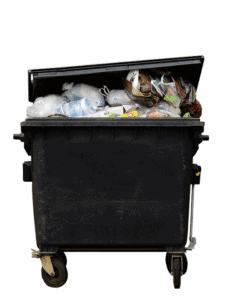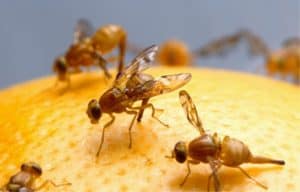What Does a Pest Control Technician See When He Eats at Your Restaurant?
Preface: This article is written from a Pest Control Technician’s point of view. The purpose of the article is to demonstrate several common things that restaurant owners and managers may want to address before they are noticed by their customers. The situations discussed here are found at restaurants of all types and price ranges.
The parking lot is full, there are people waiting outside to get a seat, and all I can think about is a juicy sirloin steak. I’ve heard this restaurant has really good food, but even before I walk up to the front door I notice a few things that make me question where, and furthermore, what I may end up eating tonight.
As I walk from my car to the front entrance, I can’t help but notice the dirty dumpster area and the faint smell of trash. This immediately throws up a red flag. 
Why?
Food waste management is one the toughest tasks a restaurant can deal with, and in some areas, there are laws and ordinances regarding proper food waste handling and disposal. Food waste is an extremely valuable resource for scavengers like rats, mice, and cockroaches… and the spilled pieces and garbage laying outside the dumpster is a golden invitation for trouble. Once a rodent population discovers the food source, they will begin frequenting the area and nesting closer to the food source. Roach populations can explode in and around dumpsters, and often times will hitch a ride on the trash cart, which ends up back in the kitchen!
As I walk toward the front door, the spider webs are in plain sight over the entrance. It’s a good thing my girlfriend isn’t with me – she hates spiders.
Why?
Americans really do judge a book by its cover. This is exactly the reason a lot of local restaurants have installed outside bars – if it looks like people are having fun, it must be a great place to go. If there are bugs and spider webs all over the exterior of your restaurant, what might people think about the inside?
I approach the hostess and ask for a table. She politely lets me know there will be a 20 minute wait. She hands me a pager and I walk over to the bar to have a seat. The place is dimly lit, but as I sit waiting for the bartender I start (discretely) examining the cracks and crevices in the bar. I also look around the taps to see if anything is flying around.
Why?
Bar areas are wet, full of sugary drinks, and are usually dimly lit. Like my friends, cockroaches and fruit flies love bars. At too many bars, fruit flies are often found buzzing around customer’s  faces, in addition to the soda and beer taps. Roaches prefer the cracks and crevices a bar can provide. Once they are hiding, or “harboring” as we call it, they deposit fecal matter in and around those cracks. Fecal spotting is the number one indicator of a roach infestation in a restaurant. Roaches often carry nasty diseases like E. Coli and Salmonella, and spread those pathogens to surfaces like bars, tables, plates, and silverware. Roaches can also spread the pathogens directly to the food. Many people have eaten at a restaurant and become ill with food poisoning, only to assume something wasn’t cooked correctly. Many of those cases could be attributed to cockroach exposure rather than incorrect food prep.
faces, in addition to the soda and beer taps. Roaches prefer the cracks and crevices a bar can provide. Once they are hiding, or “harboring” as we call it, they deposit fecal matter in and around those cracks. Fecal spotting is the number one indicator of a roach infestation in a restaurant. Roaches often carry nasty diseases like E. Coli and Salmonella, and spread those pathogens to surfaces like bars, tables, plates, and silverware. Roaches can also spread the pathogens directly to the food. Many people have eaten at a restaurant and become ill with food poisoning, only to assume something wasn’t cooked correctly. Many of those cases could be attributed to cockroach exposure rather than incorrect food prep.
Fact #1: Nothing kills your restaurant’s reputation like food poisoning.
Fact #2: A bartender will tell you whatever you want to know.
The bartender asks me what I would like to drink, so I order a beer. As the bartender taps my beer, I ask if they have seen any critters behind the bar lately. With a polite, “Nothing today!” I receive my beer and before sipping, examine the rim of my glass.
Why?
Bartenders tend to be very social people and know that guest engagement sells. They also see a lot behind the bar, which includes roach and rodent activity. Rodent activity behind a bar is very common due to the combination of moisture, heat, and food. Rodents and roaches will nest inside the refrigerator compressors, inside the bar itself, or follow mechanical lines leading to the bar for food. Many restaurants serve peanuts, pretzels, and food at the bar and pieces are continually falling behind equipment creating a veritable smorgasbord for these critters.
Glass rims can be a favorite resting spot for Red Eyed Fruit Flies. They will often times defecate on the rims as they sit, which goes unnoticed by the bartender in the dimly lit environment. Glasses are often air dried on a cart behind the bar, right where the Fruit Fly infestation is worst.
My pager starts buzzing, so I approach the hostess to be seated. She seats me at a booth. Perfect. Before sitting down, I quickly look at the cushion seams. Once the hostess leaves, I quickly pull up the booth seat and peak inside.
Why?
If the seams of the booth have a lot of crumbs and filth on them, the void underneath the booth is probably much worse. Of all the places in a restaurant, I see more rodent droppings under these booths than anywhere else in the restaurant. Roaches also love these areas, especially when they are located near a moisture source like a bar or bathroom. Rodents and rodent droppings often carry nasty diseases like Salmonella, Hantavirus, Leptospirosis, and Rat Bite Fever. Rodents will often harbor under these booths and then come out at night when the restaurant is closed, potentially crawling over food preparation and contact surfaces. Rodents communicate through urine marks, and they will urinate over surfaces during that time. Any food or food handling item that comes into contact with the feces or urine can become contaminated.
As I finish my meal, I decide to take a walk to the restroom to wash my hands. As I open the door, the very first thing I notice is the condition of the tile and grout. As I walk up to the sink, I look at the light fixture and the sink surround. As I finish washing my hands, I peek under the sink.
Why?
Cracks in the tile and grout are a huge harboring opportunity for roaches. Bathrooms are always wet, which means they are very likely to be a roach hotspot. If sink surrounds are not sealed properly, roaches will harbor in those areas as well. The underside of the sink is a definite hotspot, usually under the lip of the sink itself. Pipe chases that are not properly sealed provide easy access to the wall void for rodents as well. Again, roaches can carry diseases which could be spread to the damp bathroom surfaces, soap dispenser, paper towel dispenser, or even toilet seats. Many restaurant restrooms are located next to the kitchen due to plumbing logistics, which make them even more of an issue.
In summary, it’s important for any restaurant owner or manager to understand that proper, adequate pest control should always be a priority. There are very significant risks to your guests, employees, and reputation when they are exposed to these pest issues. In today’s fast-paced society where news travels quicker than ever before and a message can be spread almost instantly, the last thing a restaurant wants to see on Facebook is a complaint about bugs, rodents, or food poisoning.
When will a Pest Control Technician eat at YOUR restaurant again?

Lawn Care
Green Giant Home & Commercial’s Lawn Care services control weeds, build the thickness and density of your lawn and protect it from being damaged by insects and disease, providing you with a great-looking, healthy lawn. We offer fertilization, weed control, liming, insect control, and aeration and overseeding. Visit our Lawn Care page for more information.
Tree Care
Green Giant performs: Proper Diagnosis and Treatment of Tree & Shrub Problems, Insect & Disease Control (including Spotted Lanternfly), and Nutrient Management via Deep Root Fertilization to keep your plants healthy and thriving. Visit our Tree Care page for more information.
Vegetation Management
Green Giant’s Non-Lawn Weed Control services eliminate unwanted vegetation in a wide variety of locations for both residential and large commercial/municipal properties. Areas include fence lines, around obstacles to reduce weed eating, stone/gravel driveways & parking lots, swales, roadside/curbside vegetation management and more. Find more information, visit our Vegetation Management page.
Pest Control
Our full service pest control division provides both Year-Round Service Programs that cover the vast majority of pests that you will encounter and also One-Time Corrective Services for pests such as bees, ants, termites or mice. For more information, visit our Pest Control page.